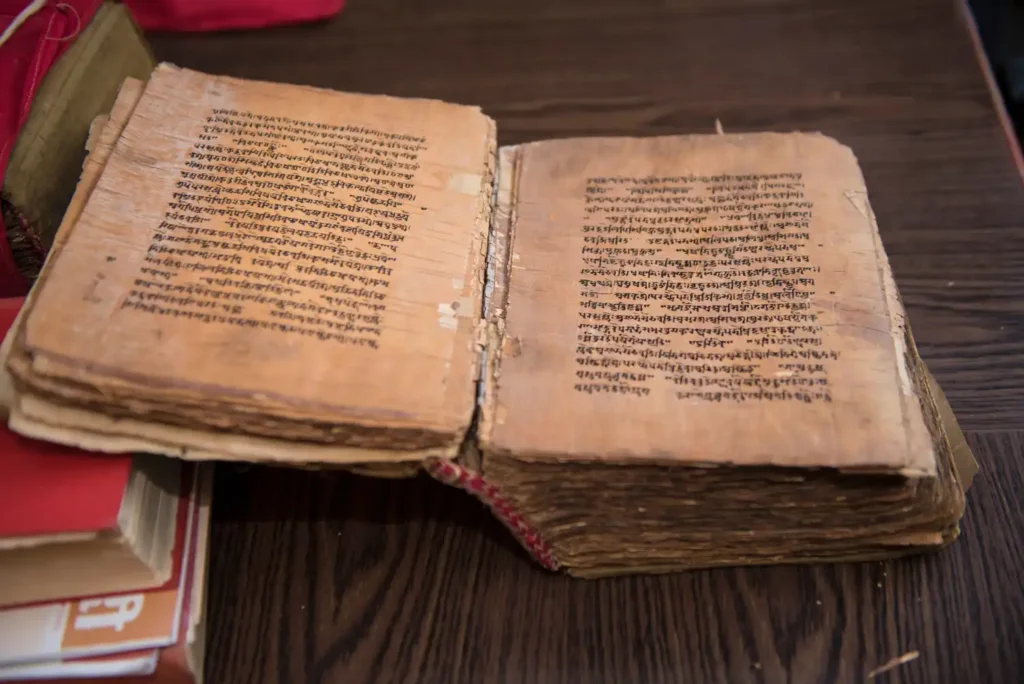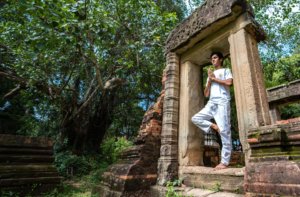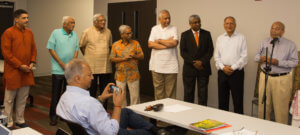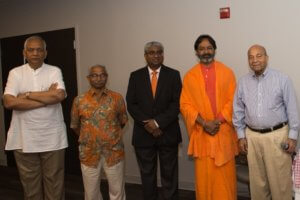Published by Dr. Kuldip Dhiman on Feb 2, 2023 11:03:57 AM
Maharśi Vālmīki is known mainly for writing the epic Rāmāyaṇa but very few know that he also wrote another equally profound book called Uttara Rāmāyaṇa, Mahārāmāyaṇa, Ārśa-Rāmāyaṇa, Jñānavāsiṣṭha, Vāsiṣṭharāmāyaṇa, more popularly the Yogavasistha. While Rāmāyaṇa is an evergreen epic that has over 250 versions in different languages, very few have ever heard of the Yogavāsiṣṭha. This is rather unfortunate because the Yogavāsiṣṭha is a philosophical work that covers every aspect of Vaidika philosophy in great depth. Perhaps no other Indian text explores the nature of the human mind as the Yogavasistha does. The two most important questions we can ask concern how to live a good life, and how to attain supreme bliss. One is about ‘ought’ and the other about knowing the ‘self’. In the Rāmāyaṇa, Vālmīki showed how one ought to live a good life, how a king ought to rule, and how a husband, a wife, a brother, and friends ought to be

By learning the ‘ought’s’ of life, we can lead a good life, but this does not make us free of suffering. Even a so-called ‘good’ person maybe plagued with troubles such as anger, envy, jealousy, disease and old age and, ultimately, death. Being a good person is not enough; something more is required. It is to teach this ‘something more’ that Vālmīki wrote the Yogavasistha. In fact, one can properly understand the popular Rāmāyaṇa only by reading the Yogavāsiṣṭha.
The sheer volume of the Yogavāsiṣṭha is enough to deter most readers. It is stated in the Yogavasistha itself that it consists of 32,000 verses divided into six books (Prakaraṇams), namely: the Vairāgya Prakaraṇam, the Mumukṣuvyavahāra Prakaraṇam, the Utpatti Prakaraṇam, the Sthiti Prakaraṇam, the Upaśama Prakaraṇam, the Nirvāṇa Prakaraṇam (Pūrvārdha) and the Nirvāņa Prakaraṇam (Uttarārdha). The number of verses is, in fact, much less. In the introduction to Śrimadvālmīkimahaṛṣṭpraṇītaḥ Yogavāsiṣṭhaḥ, G. V. Tagare puts the number at 23,734 verses.1
The first book, the Vairāgya Prakaraṇam, describes Rāma’s disillusionment with the world. The issue discussed here is whether jñāna (knowledge of the self) or karma (work, effort) is more important in attaining liberation from the misery of the world. The answer is that both are equally important, just as a bird needs both wings to fly.
The Mumukṣuvyavahāra Prakaraṇam is about the qualities of true seekers of liberation and their mental attitude. How the world was created and how it evolved is discussed in the Utpatti Prakaraṇam. The Sthiti Prakaraṇam talks about the preservation of the universe. The world appears to be real, but with the realization of Brahman, the mind is silenced and the world appears as nothing but Brahman. The Upaśama Prakaraṇam is about quieting the mind through proper understanding; the Nirvāņa Prakaraṇam, as the name suggests, is about ultimate freedom. It suggests that knowledge of the self is the best way to break free from the miseries of the world.
It has to be pointed out that the structure of the Yogavasistha is very loose, and apart from the first Prakaraṇam, almost all the major themes are discussed and repeated throughout this mammoth text. As to the division of chapters within each Prakaraṇam, again there seems to be no order. Some chapters have as few as six verses, while others run into hundreds. Often a chapter ends abruptly, and the discussion is continued in the next chapter and the next. Often, while one concept is being discussed, there is a sudden digression and another topic begins. Later the speaker returns to the previous conversation. The Nirvāņa Prakaraṇam is as large as the first five combined. For some reason it is itself divided into two huge sections: the Nirvāņa Prakaraṇam (Pūrvārdha) and the Nirvāņa Prakaraṇam (Uttarārdha).
Interlaced with the dialogue are approximately fifty-five allegorical stories and stories within stories to illustrate the philosophical matters discussed. Here again, certain stories are told in about ten verses, while others, such as that of Cudālā, stretch over several chapters.
All these stories and subplots make it difficult for the modern reader to keep track of who is speaking to whom. For instance, the Yogavasistha begins with a Brahmin named Sutīkṣṇa who goes to the sage Agasti and asks about ways to get out of the misery of the world. To answer his question, Agasti tells him the story of Kāruṇya, a very learned man, well-versed in the scriptures, who has lost interest in life. Noticing this, his father tells him the story of King Ariṣtanemi, who is sent to Vālmīki for the resolution of his sorrows. Vālmīki then tells Ariṣtanemi the story of Rāma’s dialogue with Vasiṣṭha.
Encyclopedic in its scope, the Yogavāsiṣṭha deals with ontology, epistemology, metaphysics, ethics, and psychology. The underlying philosophy of the Yogavasistha is predominantly of Advaita Vedānta. There are several verses of the Yogavāsiṣṭha which are also found in other Upanişads and the Bhagavadgītā. B. L. Atreya made an exhaustive comparative chart, and believed that being a voluminous scripture the Yogavāsiṣṭha may not have been freely available in the days when books were written by hand. Anthologists must have picked up some useful verses from it and used them to create new Upanişads.2
Yogavasistha Core philosophy
Although the Yogavāsiṣṭha is voluminous, its central message can be expressed in a few statements: Nothing exists except absolute consciousness (also called universal consciousness or Brahman), and the world is the imagination of this universal consciousness. The universal consciousness is absolute and perfect. All change happens in the phenomenal world, (which has no independent existence, as it is just an imagination of absolute consciousness). All the beings of the world are no different from the universal consciousness, as they emerged out of it. All the misery that is experienced by individual beings happens because they mistakenly identify themselves with their body and forget that they are essentially the same as the universal consciousness, Brahman. Since misery arises out of ignorance of the self, it ends with knowledge of the self. Ajātivāda says that the world was never created (aja) as it is imaginary or illusory. What can we say about the origin of a thing that is imaginary? It was there always as imagination of absolute Brahman, hence we cannot ask the question when it was born. Only Brahman truly exists, and Brahman or the absolute is non-dual.
The scriptures are words of the enlightened to awaken those who are taking their dream to be real. Once we wake from the dream, we realize that nothing has to be gained because nothing was ever lost. No one has to be liberated because there was no bondage in the first place as the absolute can never be bound.
न बन्धोऽस्ति न मोक्षोऽस्ति देहिनः परमार्थतः।
मिथ्येयमिन्द्रजालश्रि: संसारपरिवर्तिनी।।
Ultimately, there is neither bondage nor liberation for the self;
Illusion alone keeps all trapped in the vicious cycle of the world.3
All that ends after knowledge dawns is the illusory world, not the eternally blissful self. Liberation and bliss are our intrinsic nature (svabhāva), and svabhāva means that which can never be taken away from us. The truth, therefore, is that the mind has no existence other than in the imagination of absolute. That absolute is not nothingness; it is complete and encompasses all, and whatever emerges from it is also absolute.
पूर्णात्पूर्ण विसरति पूर्णे पूर्णे विराजते।
पूर्णमेवोदितं पूर्णे पूर्णमेव व्यवस्थितम्।।
From the whole emerges the whole, and the whole is situated in the whole;
Thus, whatever is there in the whole exists in its wholeness.4
Vasişţha relies solely on reason. He does not advocate any kind of blind faith, worship, or rituals. It is for this reason the Yogavasistha could have a tremendous appeal to any modern thinking person, provided they have the patience to listen to the full argument. No other Indian text analyses the human condition as thoroughly as the Yogavāsiṣṭha does. Vasiṣṭha himself says:
यदिहास्ति तदन्यत्र यन्नेहास्ति न तत् क्वचित्।
इमं समस्तविज्ञानशास्त्रकोशं विदुर्बुधाः।।
What is in it is nowhere else, what is not in it is not elsewhere;
Hence the learned have called it a repository of scriptures.5
People normally think that those who seek self-liberation ought to withdraw from active life and lead the life of a hermit − praying, meditating, and performing rituals. Vedānta does not advocate this type of life. It says that you ought to go on doing whatever you are supposed to, but remember all the time that you are not the doer. Do everything with a sense of detachment and be unaffected by whatever is happening around you, just as a lotus grows in a pond without getting wet.
The Yogavasistha does not advocate worship of any kind, rituals, neither ablutions nor prayer to a deity, not even meditative techniques. It, however, seriously discourages escapism and laziness, and strongly advocates human effort.
स्वपौरुषप्रयत्नेन विवेकेन विकासिना।
स देवो ज्ञायते राम न तप:सनानकर्मभि:।।
Through effort and maturity alone is the self known, Rāma,
Not through penance, holy bath, and other such actions.6
Rāma’s dialogue with Vasiṣṭha, after which Rāma becomes free of the miseries of the world. The book which narrates this dialogue is called the Yogavāsiṣṭha. It is said that one can become free of worldly miseries merely by reading the Yogavasistha.
After Vālmīki wrote the epic Rāmāyaṇa, called in full, Pūrva Rāmāyaṇa, he was approached by Brahmā, the creator of the world, to write a book that would free humans of worldly misery and make them eternally blissful. Thus was born the scripture known variously as Uttara Rāmāyaṇa, Mahārāmāyaṇa, Ārśa-Rāmāyaṇa, Jñānavāsişţha, Vasiṣṭharāmāyaṇa, more popularly called the Yogavāsiṣṭha.
Liberation for all
One striking feature of the Yogavāsiṣṭha is that its vision is secular. Furthermore, it does not believe in gender, race or caste discrimination. All that is required on the part of a seeker is to be a sincere and determined disciple. In fact, the main character of one of its longest stories is a queen named Cudālā. She not only acquires self-knowledge but also teaches her husband the means of acquiring it. The Yogavāsiṣṭha goes even further by showing that one need not be of high birth to attain self-knowledge: anyone can have it. It names people from lower castes and wild tribes, and gives instances where animals, too, become liberated. Even Śeşanāga, the deadly snake, is liberated, as is Kākabhuşuņda, the crow. This might sound far fetched, but the point being made here is that anyone can become blissful if they really wish to.
1. Pansikar, Vasudeva Laxmana Sharma (Ed.), Srimadvālmīkimahāŗşpraņītaĥ Yogavāsiṣṭhaḥ Vol I, Motilal Banarsidass Publishers, Delhi, p VII
2. Atreya B. L., Yogavāsiṣṭha aur Uske Sidhdhant, Shri Krishna Janamsthan Seva Sansthan, Mathura 1986, p4; for comparative charts see pages
45-59, 67-69 of the same book.
3. Yogavāsiṣṭha V:18:27
4. Yogavāsiṣṭha VIB:53:20
5. Yogavāsiṣṭha III:8:12
6. Yogavāsiṣṭha III:6:9










